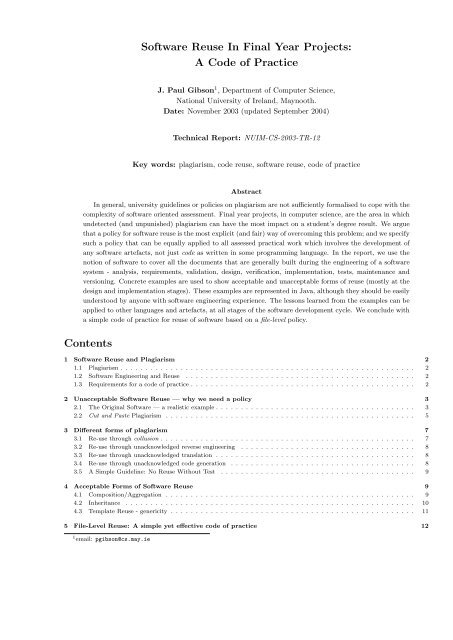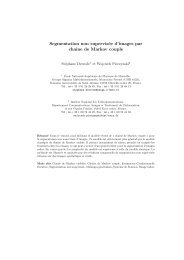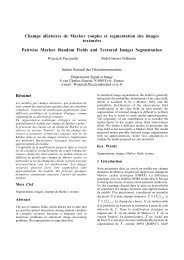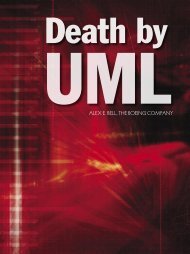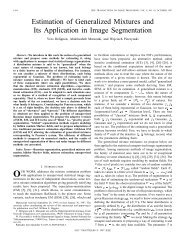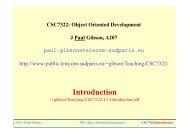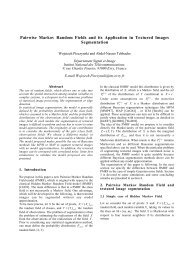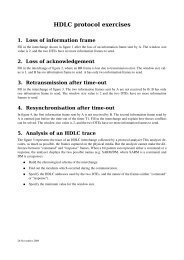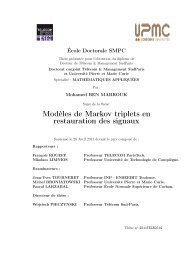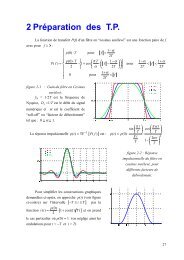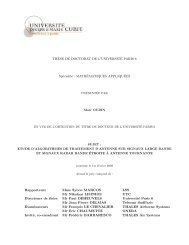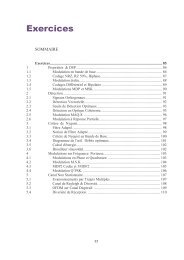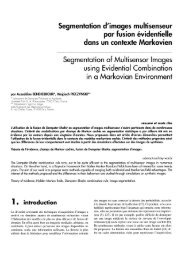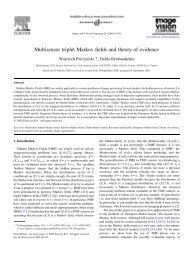Software Reuse In Final Year Projects: A Code of Practice Contents
Software Reuse In Final Year Projects: A Code of Practice Contents
Software Reuse In Final Year Projects: A Code of Practice Contents
Create successful ePaper yourself
Turn your PDF publications into a flip-book with our unique Google optimized e-Paper software.
<strong>S<strong>of</strong>tware</strong> <strong>Reuse</strong> <strong>In</strong> <strong>Final</strong> <strong>Year</strong> <strong>Projects</strong>:A <strong>Code</strong> <strong>of</strong> <strong>Practice</strong>J. Paul Gibson 1 , Department <strong>of</strong> Computer Science,National University <strong>of</strong> Ireland, Maynooth.Date: November 2003 (updated September 2004)Technical Report: NUIM-CS-2003-TR-12Key words: plagiarism, code reuse, s<strong>of</strong>tware reuse, code <strong>of</strong> practiceAbstract<strong>In</strong> general, university guidelines or policies on plagiarism are not sufficiently formalised to cope with thecomplexity <strong>of</strong> s<strong>of</strong>tware oriented assessment. <strong>Final</strong> year projects, in computer science, are the area in whichundetected (and unpunished) plagiarism can have the most impact on a student’s degree result. We arguethat a policy for s<strong>of</strong>tware reuse is the most explicit (and fair) way <strong>of</strong> overcoming this problem; and we specifysuch a policy that can be equally applied to all assessed practical work which involves the development <strong>of</strong>any s<strong>of</strong>tware artefacts, not just code as written in some programming language. <strong>In</strong> the report, we use thenotion <strong>of</strong> s<strong>of</strong>tware to cover all the documents that are generally built during the engineering <strong>of</strong> a s<strong>of</strong>twaresystem - analysis, requirements, validation, design, verification, implementation, tests, maintenance andversioning. Concrete examples are used to show acceptable and unacceptable forms <strong>of</strong> reuse (mostly at thedesign and implementation stages). These examples are represented in Java, although they should be easilyunderstood by anyone with s<strong>of</strong>tware engineering experience. The lessons learned from the examples can beapplied to other languages and artefacts, at all stages <strong>of</strong> the s<strong>of</strong>tware development cycle. We conclude witha simple code <strong>of</strong> practice for reuse <strong>of</strong> s<strong>of</strong>tware based on a file-level policy.<strong>Contents</strong>1 <strong>S<strong>of</strong>tware</strong> <strong>Reuse</strong> and Plagiarism 21.1 Plagiarism . . . . . . . . . . . . . . . . . . . . . . . . . . . . . . . . . . . . . . . . . . . . . . . . . . . . . . . . . . . 21.2 <strong>S<strong>of</strong>tware</strong> Engineering and <strong>Reuse</strong> . . . . . . . . . . . . . . . . . . . . . . . . . . . . . . . . . . . . . . . . . . . . . . 21.3 Requirements for a code <strong>of</strong> practice . . . . . . . . . . . . . . . . . . . . . . . . . . . . . . . . . . . . . . . . . . . . . 22 Unacceptable <strong>S<strong>of</strong>tware</strong> <strong>Reuse</strong> — why we need a policy 32.1 The Original <strong>S<strong>of</strong>tware</strong> — a realistic example . . . . . . . . . . . . . . . . . . . . . . . . . . . . . . . . . . . . . . . . 32.2 Cut and Paste Plagiarism . . . . . . . . . . . . . . . . . . . . . . . . . . . . . . . . . . . . . . . . . . . . . . . . . . 53 Different forms <strong>of</strong> plagiarism 73.1 Re-use through collusion . . . . . . . . . . . . . . . . . . . . . . . . . . . . . . . . . . . . . . . . . . . . . . . . . . . 73.2 Re-use through unacknowledged reverse engineering . . . . . . . . . . . . . . . . . . . . . . . . . . . . . . . . . . . 83.3 Re-use through unacknowledged translation . . . . . . . . . . . . . . . . . . . . . . . . . . . . . . . . . . . . . . . . 83.4 Re-use through unacknowledged code generation . . . . . . . . . . . . . . . . . . . . . . . . . . . . . . . . . . . . . 83.5 A Simple Guideline: No <strong>Reuse</strong> Without Test . . . . . . . . . . . . . . . . . . . . . . . . . . . . . . . . . . . . . . . 94 Acceptable Forms <strong>of</strong> <strong>S<strong>of</strong>tware</strong> <strong>Reuse</strong> 94.1 Composition/Aggregation . . . . . . . . . . . . . . . . . . . . . . . . . . . . . . . . . . . . . . . . . . . . . . . . . . 94.2 <strong>In</strong>heritance . . . . . . . . . . . . . . . . . . . . . . . . . . . . . . . . . . . . . . . . . . . . . . . . . . . . . . . . . . 104.3 Template <strong>Reuse</strong> - genericity . . . . . . . . . . . . . . . . . . . . . . . . . . . . . . . . . . . . . . . . . . . . . . . . . 115 File-Level <strong>Reuse</strong>: A simple yet effective code <strong>of</strong> practice 121 email: pgibson@cs.may.ie
1 <strong>S<strong>of</strong>tware</strong> <strong>Reuse</strong> and Plagiarism1.1 PlagiarismAt all stages <strong>of</strong> education and learning, including University, reuse <strong>of</strong> other peoples’ work and ideas is fundamental.It is actively encouraged, it is not forbidden and it does not constitute plagiarism. What is notencouraged is when the work <strong>of</strong> another person is presented as your own (willfully or not). This is plagiarismand will not be tolerated.It is your responsibility - whether in your role as a student, or as a scientist or as an engineer - to ensurewhen you include (directly or indirectly) the work <strong>of</strong> others that this contribution is fully and properly acknowledged.Guidelines on the acknowledgment <strong>of</strong> the work <strong>of</strong> others can be found in a text by Gordon Harvey[5].Pr<strong>of</strong>essional bodies (with publishing houses) also provide guidelines on plagiarism (the ACM student magazineCrossroads is a good example 2 . Universities generally have their own policies (or guidelines) on plagiarism 3and students in all departments must be made aware <strong>of</strong> them. <strong>In</strong>dividual departments may also provide morespecific guidelines 4 , and one must be careful that these documents are consistent.<strong>In</strong> our experience, however welcome these documents are, they do not cover many <strong>of</strong> the more difficult,technical issues which arise when the work that is being reused is s<strong>of</strong>tware. It is the role <strong>of</strong> this document totry and clarify what is meant by plagiarism in this context.1.2 <strong>S<strong>of</strong>tware</strong> Engineering and <strong>Reuse</strong><strong>In</strong> s<strong>of</strong>tware engineering, s<strong>of</strong>tware is usually not built from scratch[7]. Normally, already existing s<strong>of</strong>twareartefacts (from the set <strong>of</strong> documents and models that are built during the engineering <strong>of</strong> a s<strong>of</strong>tware system- analysis, requirements, validation, design, verification, implementation, tests, maintenance, versioning andtools) are reused, in a wide range <strong>of</strong> ways, in the construction <strong>of</strong> a ‘new’ s<strong>of</strong>tware system.<strong>S<strong>of</strong>tware</strong> reuse is one <strong>of</strong> the least-well understood elements <strong>of</strong> the s<strong>of</strong>tware engineering process[3]. A discipline<strong>of</strong> reuse has yet to be rigorously accepted or applied and, as a consequence, s<strong>of</strong>tware reuse is <strong>of</strong>ten donein an ad-hoc fashion. It is much more challenging to reuse s<strong>of</strong>tware artefacts in a controlled, systematic way– the quality <strong>of</strong> s<strong>of</strong>tware is compromised if a rigorous engineering approach to reuse is not followed. Clearly,any piece <strong>of</strong> assessed work incorporating the development <strong>of</strong> s<strong>of</strong>tware (including final year projects) can beconsidered to be <strong>of</strong> ‘poor’ quality if it has relied upon non-rigorous, ad-hoc reuse <strong>of</strong> other peoples’ s<strong>of</strong>tware.1.3 Requirements for a code <strong>of</strong> practiceWe propose that a code <strong>of</strong> practice for s<strong>of</strong>tware reuse <strong>of</strong>fers many advantages to students submitting work forevaluation:• makes explicit what constitutes plagiarism with respect to s<strong>of</strong>tware,• provides guidelines which, if followed, should ensure that a student is not wrongly accused <strong>of</strong> plagiarism,• defines structures to help examiners to objectively check for plagiarism in a consistent and fair manner,and2 See www.acm.org/crossroads/doc/information/wg/plagiarism.html3 NUI Maynooth make an explicit statement in the University Calendar — in 2004 this can be found on pages 77 and 78— providing a Guide to Students complemented by a statement <strong>of</strong> the Disciplinary Consequences. We make reference to thisdocument, where appropriate, later in this report.4 The Computer Science Department at NUIM provides a final year project handbook[6] that covers plagiarism.2
• improves the quality <strong>of</strong> the s<strong>of</strong>tware that students produce.We acknowledge that any code <strong>of</strong> practice will obviously restrict the way in which s<strong>of</strong>tware can be developed.Furthermore, such a code will almost certainly be too restrictive in the sense that there are sure to be specificrequirements for some system that would be impossible 5 to meet in the time-frame <strong>of</strong> a project if the code <strong>of</strong>practice is enforced, but otherwise could possibly be met. For this reason we propose that exceptional cases bedealt with by the project supervisor (see section 5 for details).The fundamental requirements for the code <strong>of</strong> practice are that it is: simple to understand, apply andenforce; consistent with wider plagairism policy; and as fair as possible to all students. We will return to theserequirements in the final section <strong>of</strong> this report.<strong>In</strong> order to guide the formulation <strong>of</strong> the code <strong>of</strong> practice, we propose that concrete examples <strong>of</strong> acceptableand unacceptable forms <strong>of</strong> reuse be examined. These examples are not intended to be complete. The exampleswere chosen because they represent the most common forms <strong>of</strong> reuse that we have witnessed in final yearprojects (both acceptable and unacceptable). As such reuse has mostly been at the design and implementationstages <strong>of</strong> development, we focus our examples on these levels <strong>of</strong> abstraction. However, the lessons to be learnedare applicable to the reuse <strong>of</strong> all s<strong>of</strong>tware artefacts.We chose Java as the modelling language used to build the s<strong>of</strong>tware artefacts (models) in our examples. Thischoice reflects our students’ s<strong>of</strong>tware modelling experience, where the majority are most comfortable workingwith object oriented programming languages, in general, and Java in particular.2 Unacceptable <strong>S<strong>of</strong>tware</strong> <strong>Reuse</strong> — why we need a policy<strong>In</strong> this section we explicitly identify — through a single, simple piece <strong>of</strong> Java — a number <strong>of</strong> unacceptable ways<strong>of</strong> reusing other peoples’ s<strong>of</strong>tware. The types <strong>of</strong> reuse in the example also illustrate bad engineering practicewhen reusing your own 6 s<strong>of</strong>tware. Such reuse is common in s<strong>of</strong>tware engineering because the construction<strong>of</strong> most models is incremental, where some, or all, <strong>of</strong> the model/code in a previous increment is reused in afollowing increment. Although the reuse <strong>of</strong> your own code in the way illustrated by the example in this sectionis not explicitly forbidden, we do recommend that you follow our guidelines for acceptable forms <strong>of</strong> reuse, evenwhen reusing your own code!2.1 The Original <strong>S<strong>of</strong>tware</strong> — a realistic example<strong>In</strong> this subsection we introduce a s<strong>of</strong>tware artefact/model, in the form <strong>of</strong> Java source code, which forms thebasis <strong>of</strong> discussion about unacceptable forms <strong>of</strong> reuse. Note that, like much <strong>of</strong> the code that is reused bystudents, this artefact was not designed for reuse!Let us now examine what this code does and how it may be reusable. Firstly, we note that the code consists<strong>of</strong> 2 classes: Example1 and <strong>In</strong>tArray. The Example1 class appears to be a simple test driver for the <strong>In</strong>tArrayclass. By running the code, and through examination <strong>of</strong> the sample execution which is provided as a comment5 The impossibility may also be due to the nature <strong>of</strong> the project - if it explicitly requires ad-hoc re-use then it is clear that thecode <strong>of</strong> practice cannot be followed. <strong>In</strong> situations like these, it should be the responsibility <strong>of</strong> the project supervisor to guide thestudent through such s<strong>of</strong>tware engineering bad practice.6 We do not address the question <strong>of</strong> ownership or <strong>In</strong>tellectual Property in this report. We use the notion <strong>of</strong> your own code torefer to code you have written yourself; <strong>of</strong> course, you may or may not actually have ownership over it.3
at the end <strong>of</strong> the file listing, we see that the code appears 7 to generate an array <strong>of</strong> 12 integers whose values areinitialised randomly to be in the range 1 to 8. It then prints out this array, sorts it and prints out the arrayagain. It also counts the number <strong>of</strong> comparisons and swaps that were performed in the process <strong>of</strong> sorting thearray.// Example1.java - sorting an integer array// Author Dr J Paul Gibson// Version 1 - 29/10/2003// For use in TR-2003-12// <strong>Code</strong> <strong>of</strong> practice for reuse <strong>of</strong> s<strong>of</strong>twareclass <strong>In</strong>tArray {int size;int max;int numswaps;int numcomparisons;int [] values;<strong>In</strong>tArray (int size, int maxvalue){reset(size, maxvalue);}// end <strong>In</strong>tArray constructorpublic void reset(int size<strong>In</strong>, int max<strong>In</strong>){size = size<strong>In</strong>; max = max<strong>In</strong>;values = new int [size];randomize();}// end resetpublic void randomize(){for (int i =0; i values[j];}else return false;}// end comparepublic void swap(int i, int j){if (i=0 && j=0){numswaps++;int temp = values[i]; values[i] = values[j]; values[j] = temp;}}// end swappublic void sort(){for (int i =0; i
}// end sortpublic String toString(){String str =" size: "+size+" max: "+max+" values: ";for (int i=0; i
class MyArray {int size;int max;int [] values;MyArray (int size, int maxvalue){reset(size, maxvalue);}public void reset(int size<strong>In</strong>, int max<strong>In</strong>){size = size<strong>In</strong>;max = max<strong>In</strong>; values = new int [size];randomize();}public void randomize(){for (int i =0; i
• <strong>In</strong> the compare method, a ‘>’ is changed to a ‘
e treated as deliberate deception and will result in the student (or students) being sent to the disciplinarycommittee 11 :“ . . . Penalties imposed may involve suspension or expulsion from the course and from the University. . . ”3.2 Re-use through unacknowledged reverse engineeringOften s<strong>of</strong>tware engineers will look at some code and be able to reverse engineer[4] some abstract property <strong>of</strong>that code in order to reuse that abstraction to help them write their own code, usually as a solution to adifferent, yet similar, problem. When the original piece <strong>of</strong> code is not acknowledged then this is also commonlyknown as “stealing someone else’s idea(s)”.<strong>In</strong> final year projects, this type <strong>of</strong> plagiarism <strong>of</strong>ten results when a student reuses the design <strong>of</strong> a s<strong>of</strong>twaresystem (or part <strong>of</strong> a s<strong>of</strong>tware system) as a structure, template or pattern for their own code.Students should not be discouraged from engineering s<strong>of</strong>tware in this way (it is a reasonably advancedtechnique) but they should be strongly encouraged to correctly acknowledge where the original design (idea)originated.<strong>S<strong>of</strong>tware</strong> design is a challenging part <strong>of</strong> the s<strong>of</strong>tware engineering life cycle; and good innovative design shouldbe recognised in the evaluation <strong>of</strong> any project. Reusing other engineers’ designs without proper acknowledgementis as bad as reusing their code in the same way. <strong>In</strong> industry, this would usually be considered a worsecase scenario because <strong>of</strong> the higher risk <strong>of</strong> patent infringement.3.3 Re-use through unacknowledged translationImagine that a student is required to write code that provides exactly the same behaviour as seen in Example1,but is required to code it in C++. The student “finds” the Java code and reuses it to generate 12 C++ code.This can be thought <strong>of</strong> as a specific form <strong>of</strong> re-use through abstraction.Again, this may be considered a good approach in some circumstances, provided the original code is properlyacknowledged. A student who choses not to acknowledge the original code will be considered to have attemptedto deliberately deceive the examiners <strong>of</strong> their work, and this will result in them being brought to the disciplinarycommittee.3.4 Re-use through unacknowledged code generation<strong>S<strong>of</strong>tware</strong> engineering tools, <strong>of</strong>ten found as part <strong>of</strong> complex development environments, can be used to automaticallygenerate code. Any such generated code must be explicitly identified and correctly acknowledged.Note that these tools usually credit themselves, so removing these credits would be considered as deliberatedeception on the part <strong>of</strong> the student, and disciplinary action would follow.A common form <strong>of</strong> plagiarism is to use a tool to reverse engineer design documentation from implementationcode (from Java to UML, for example). This is not always bad practice 13 when it is properly acknowledged.It is very bad practice if not properly acknowleged.11 NUIM University Calendar 2004, page 78.12 This generation may, or may not, be assisted by tools — see the next subsection.13 It is usually a result <strong>of</strong> bad practice when done by students during their final year projects!8
The code generation can also go in the other direction (from abstract to concrete). For example, there aretools to generate C++ code from data flow diagrams. This type <strong>of</strong> automated s<strong>of</strong>tware engineering is good,provided the role <strong>of</strong> the tool is properly acknowledged.3.5 A Simple Guideline: No <strong>Reuse</strong> Without TestFrom the examples above, it seems that you need to be very careful about acknowledging any reuse <strong>of</strong> code.There is a simple guideline to ensure that you never forget the acknowledgement, avoiding the risk <strong>of</strong> beingaccused <strong>of</strong> deliberate deception when the plagiarism is a result <strong>of</strong> incompetency:Explicitly acknowledge the use <strong>of</strong> someone else’s code - no matter how small- by testing it againstyour requirements.<strong>In</strong> the examples that follow, in the next section, we do not explicitly state how the reused artefacts shouldbe tested in order to show that they do what they are supposed to do. <strong>In</strong> the case that a student does notproperly test the s<strong>of</strong>tware that they are reusing, this student should be advised that the reuse is unacceptable.The following guideline 14 is suggested:• If you don’t know how to test it then don’t reuse it.• If you don’t know what to test it against then don’t reuse it.• If you know what to test and how to test it, then reuse it only after the tests are successfully completed.Supervisors should advise students that it is the students who are responsible for the behaviour <strong>of</strong> the artefactsthat they reuse: if their system fails due to a defect in another person’s s<strong>of</strong>tware then this is the student’sresponsibility! Of course, reuse <strong>of</strong> good quality s<strong>of</strong>tware (like that found in library classes) does not require asmuch testing as reuse <strong>of</strong> some piece <strong>of</strong> code found on the web, for example.4 Acceptable Forms <strong>of</strong> <strong>S<strong>of</strong>tware</strong> <strong>Reuse</strong>We should note that it is usually a policy <strong>of</strong> a University that 15 :“Examiners, tutors and markers are required to report instances <strong>of</strong> suspected plagiarism . . . ”Thus, it is the responsibility <strong>of</strong> the student to ensure that their code is above suspicion. <strong>In</strong> this section weidentify useful strategies for reuse that would leave an examiner in no doubt about what has been re-used andwhat has been the original contribution <strong>of</strong> the student.4.1 Composition/AggregationConsider a problem where the chosen solution (in Java) requires two <strong>In</strong>tArray components. Typically, in highlevel languages, such <strong>In</strong>tArray behaviour can be reused without having to edit the original file in which thecode was written. <strong>In</strong> Java, the import keyword is used to reuse a package <strong>of</strong> classes (specified as a directory in14 We use the word ‘test’ to represent some sort <strong>of</strong> validation or verification, and we use the word ‘it’ to represent any s<strong>of</strong>twareartefact.15 NUIM Calendar 2004, page 78.9
which the .class files are found). An example <strong>of</strong> this is given below, where we note that the reuse <strong>of</strong> code isproperly acknowledged as a comment in the code 16// Composition.java - reuse <strong>of</strong> <strong>In</strong>tArray// Author Dr J Paul Gibson// Version 1 - 29/10/2003// For use in TR-2003-12// <strong>Code</strong> <strong>of</strong> practice for reuse <strong>of</strong> s<strong>of</strong>tware// Re-use <strong>of</strong> <strong>In</strong>tArray class written by J P Gibson// Original source file: Example1.javaimport <strong>In</strong>tArray.*;class Composition1{public static void main(String[] args){<strong>In</strong>tArray first,second;first = new <strong>In</strong>tArray(12,8);second = new <strong>In</strong>tArray(12,8);System.out.println("Composition1 - NUIM-TR-2003-12");System.out.println("first: "+ first);System.out.println("second: "+ second);}} //ENDCLASS Composition1/* TYPICAL OUTPUTComposition1 - NUIM-TR-2003-12first: size: 12 max: 8 values: 3 4 1 3 6 3 3 2 2 1 4 2number <strong>of</strong> swaps = 0 number <strong>of</strong> comparisons = 0second: size: 12 max: 8 values: 6 5 8 8 3 4 7 4 8 8 2 1number <strong>of</strong> swaps = 0 number <strong>of</strong> comparisons = 0*/4.2 <strong>In</strong>heritanceConsider a problem whose solution requires an integer array that would be sorted into descending order. The<strong>In</strong>tArray class provides very similar behaviour — it can sort the integers into ascending order. Typically,s<strong>of</strong>tware engineers could reuse the <strong>In</strong>tArray in many different ways to provide the required behaviour:• (1) Create a new class whose internal state is an <strong>In</strong>tArray component (like in the previous example).Then, provide a new method to reverse the values in the array. Then, redefine a new sort to callthe original sort routine, followed immediately by a call to reverse. (This outline design appears quitestraightforward, but if you try to code it up you will see that it is open to different implementations, all<strong>of</strong> them fairly ‘messy’.)• (2) Create a new class which extends the <strong>In</strong>tArray with a new sort method, taking a boolean parameterto specify whether the sort is to be done in ascending or descending order.16 This reuse must also be more explicitly mentioned in the design documentation. Furthermore, the reuse must be verified —by writing test code that shows that the <strong>In</strong>tArray class provides the required behaviour.10
• (3) Create a new class which overrides the <strong>In</strong>tArray sort code by making it sort in descending order• . . .Option (2) is the nicest design, but option (3) is the easiest to code 17 . For simplicity we chose a variation onoption (3) in the code below:// Extension1.java - reuse <strong>of</strong> <strong>In</strong>tArray// Author Dr J Paul Gibson// Version 1 - 29/10/2003// For use in TR-2003-12// <strong>Code</strong> <strong>of</strong> practice for reuse <strong>of</strong> s<strong>of</strong>tware// Re-use <strong>of</strong> <strong>In</strong>tArray class written by J P Gibson// Original source file: Example1.javaimport <strong>In</strong>tArray.*;class Extension1 extends <strong>In</strong>tArray{// Overrides sort method to sort ’downwards’public void sort(){for (int i =0; i
Java currently does not provide such templates as part <strong>of</strong> the standard language. Typically, if you requirea stack <strong>of</strong> ‘somethings’ you need to directly edit an already existing stack <strong>of</strong> ‘somethingelses’ by renaming alloccurences <strong>of</strong> ‘somethingelse’ by ‘something’. This is cut-and-paste programming, albeit in a more structuredand constrained style. There have been proposals to introduce genericity to the Java programming language(for example, in the form <strong>of</strong> GJava[1]). If you are using Java in any project we advise you to look at the genericextensions that are available. <strong>In</strong> particular, Java 1.5 [2] has generics functionally equivalent to templates.When working on any s<strong>of</strong>tware engineering project, the choice <strong>of</strong> programming language is central. If yourequire reuse in the form <strong>of</strong> generic components then you are advised to make sure that your choice <strong>of</strong> languagesupports it in some way. If it does not then you have to be very careful about how you acknowledge the contribution<strong>of</strong> other people’s work when you reuse their generic structures. <strong>In</strong> particular, if no proper acknowledgementis given then this would be considered as plagiarism through a specific type <strong>of</strong> reverse engineering.5 File-Level <strong>Reuse</strong>: A simple yet effective code <strong>of</strong> practiceAs the examples in the previous sections show, unacceptable forms <strong>of</strong> s<strong>of</strong>tware reuse are most easily identifiedby files that contain cut-and-paste code: i.e, code that has been produced by more than a single author. Wecannot preclude the reuse <strong>of</strong> multi-authored s<strong>of</strong>tware; however, we can preclude the submission <strong>of</strong> the student’sown work in a multi-authored file. All the examples <strong>of</strong> acceptable forms <strong>of</strong> reuse are directly supported - at thefile level - by the vast majority <strong>of</strong> modelling languages that are used in s<strong>of</strong>tware engineering. <strong>In</strong> other words,they do not require one to write cut-and-paste code.We suggest the following code <strong>of</strong> practice:(i): All s<strong>of</strong>tware that is reused will not be found in the same file as s<strong>of</strong>tware that is submitted bythe student for evaluation, unless authorised by the supervisor and justified in the documentation.(ii): All reused s<strong>of</strong>tware will be properly acknowledged in the documentation, and the student mustclearly 18 distinguish between the s<strong>of</strong>tware that they have reused and the s<strong>of</strong>tware that they havewritten themselves; and they must note in their own s<strong>of</strong>tware where the reuse occurs.(iii): All reused s<strong>of</strong>tware must be adequately 19 tested.(iv): All students who are found to have plagiarised s<strong>of</strong>tware - intentionally, or not - will bepunished 20 .To conclude, we argue that this code <strong>of</strong> practice meets all our original requirements (from section 1): it issimple to understand, it is simple to implement and enforce, it is consistent with University policy, and it isfair to the students.AcknowledgementsMany thanks to all staff and students who commented on numerous versions <strong>of</strong> this report. Particular thanksto Des Traynor for his advice on almost every aspect <strong>of</strong> the document.18 Through intelligent use <strong>of</strong> comments, fonts, colors, etc. . .19 The notion <strong>of</strong> adequate depends on the nature <strong>of</strong> the code being reused. At one extreme, classes from a standard library canalmost be considered as part <strong>of</strong> the language and should not require much testing to show that they do what they are supposedto do; provided, <strong>of</strong> course, that the person reusing the library classes understands them! At the other extreme, code that iscut-and-pasted from the web should be exhaustively tested; it is very likely that it does not do what is required to do, or claimsto do!20 Following the guidelines set down in the department’s final year project and the unversity calendar.12
References[1] E. Allen and R. Cartwright. The case for run-time types in generic java. <strong>In</strong> Proceedings <strong>of</strong> the inaugural conferenceon the Principles and <strong>Practice</strong> <strong>of</strong> programming, 2002 and Proceedings <strong>of</strong> the second workshop on <strong>In</strong>termediaterepresentation engineering for virtual machines, pages 19 – 24. ACM <strong>In</strong>ternational Conference Proceeding Seriesarchive, 2002.[2] G. Bracha. Generics in the java programming language. Sun online tutorial, Sun, July 2004.“http://java.sun.com/j2se/1.5/pdf/generics-tutorial.pdf”.[3] C. Gacek, editor. <strong>S<strong>of</strong>tware</strong> <strong>Reuse</strong>: Methods, Techniques, and Tools, 7th <strong>In</strong>ternational Conference, ICSR-7, Austin,TX, USA, April 15-19, 2002, Proceedings, volume 2319 <strong>of</strong> Lecture Notes in Computer Science. Springer, 2002.[4] G. C. Gannod and B. H. Cheng. A framework for classifying and comparing s<strong>of</strong>tware reverse engineering and designrecovery techniques. <strong>In</strong> Proceedings <strong>of</strong> the 6th Working Conference on Reverse Engineering. ACM <strong>In</strong>ternationalConference Proceeding Series archive, Oct. 1999.[5] G. Harvey. Writing with sources: A guide for students. Hackett Publishing Company, 1998. ISBN: 0872204340,URL: “http://www.fas.harvard.edu/ expos/sources/”.[6] D. O’Donoghue. <strong>Final</strong> year project handbook. Computer science department report, NUI Maynooth, Oct. 2004.“http://www.cs.may.ie/internal/fourthyearhandbook.pdf”.[7] R. Rada. <strong>S<strong>of</strong>tware</strong> <strong>Reuse</strong>. <strong>In</strong>tellect Books, 1994. ISBN: 1871516536.13


